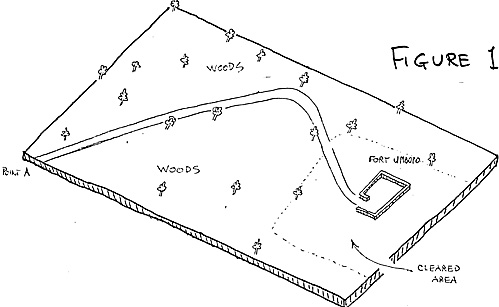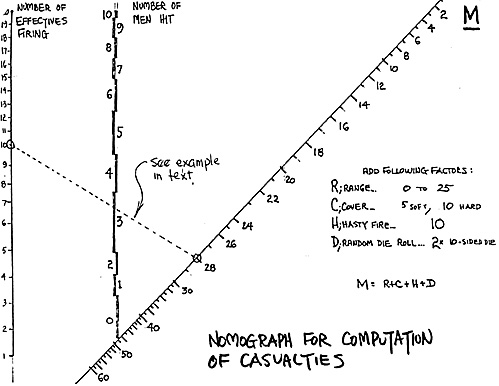 INTRODUCTION
INTRODUCTION
This scenario used a set of 33mm (!?) British Colonial and Zulu figures produced by a firm called MINIMEN. Castings were mounted on single figure stands. Figure 1 depicts the terrain. Each side was given a data sheet with specific information as shown below. The Zulus, for example, did not know that the Gatling gun was supplied with a limited amount of ammunition.
THE RULES
British:
You must re-inforce the Fort with a patrol. The patrol enters at Point A. The entire table is covered in thick woods except for the cleared area around the fort. The Gatling gun has ammo for three bursts, each equal to 12 men firing.
Zulu:
To stop the Patrol, you've 2 hand-to-hand (only) units to place anywhere on the board (mark on map) and they remain hidden unless moved in the clear or they attack. You also have one small musket unit with a 50% chance of revealing the unit if it fires.
Each Zulu figure represents 2 men--thus each figure takes two hits.
Your overall objective is to capture the gatling gun in the fort.
Range:
Rifle: 25"
Musket: 15"
Gatling Gun: 25"
Movement:
Brits: 9" in clear, 6" in woods
Zulus: 12" everywhere
The sequence used was that described in COURIER Vol 2/ No 2; Sept, Oct. 1980. The procedure is one in which the commander of each unit states what he'd like his unit to do. Referencing the commands to a chart then gives the probability of what each unit can do; a final dice throw then decides what each unit actually does.
 The firing procedure used a technique developed in prior skirmish games. Six
factors were used to calculate the effect of a given volley: the number of men in a unit, the number of wounded, range, target cover, whether or not the men fired hastily, and, lastly, a random factor. Rather than use a complex table or formula to calculate hits, the nomograph shown in the Figure was used; it quickly takes into account all the given factors and permits a rapid readout of target hits.
The firing procedure used a technique developed in prior skirmish games. Six
factors were used to calculate the effect of a given volley: the number of men in a unit, the number of wounded, range, target cover, whether or not the men fired hastily, and, lastly, a random factor. Rather than use a complex table or formula to calculate hits, the nomograph shown in the Figure was used; it quickly takes into account all the given factors and permits a rapid readout of target hits.
As an example, consider 10 men firing, none wounded, at a target under cover. The men have pivoted to fire, hence they fire hastily; the range is 7 inches and the die roll is 3:
- Range = 7
Target in soft cover = 5
Hasty fire = 10
Random element (2 x die 6 throw) = 6
M = 28
On the left of the nomograph, enter the 10 figures firing; on the riqht, enter the M value of 28. Draw a line between the two and one immediately sees that the target incurred 3 hits.
Melee was decided by the cast of a series of dice. Zulus were given a 12-sided die, British a 10-sided die. Adjustments were made for certain situations by adding different types of dice. For example, the British, defending Fort Umbopo behind stone walls, were given an extra 6-sided die to roll with their 10-sided one.
For those who relish such things, the probability that a Zulu with his 12-sided die will beat a Britisher with his 10-sided is slightly over 54%.
THE GAME
Dick Shaka Sossi of SHIP SHOP and John Mbotu Victor of WARGAMER'S CORNER volunteered to command the Zulus. The British were led by Terry Sirk and the Paladin of Potomac, Fred Haub.
No contest...Final Score...Zulus: one fort, British: 0.
That'll teach the British not to clear a sufficient field of fire around their fortification. In truth, the designated clearing was defined by the scenario designer, a sprightly lad -- slightly gray at the temples -- about whom nothing more need be said. Be that as it may, the cleared zone provided for only one British round of fire at the oncoming horde... and hasty fire at that.
The Gatling also managed to get off one burst before the Zulus fell on the crew. No use. The Paladin's forces were no more; the fort was taken.
While Shaka Sossi was storming the walls of Fort Umbopo, Mbotu Victor was having a fine time with Captain Sirk's relief patrol.
The Zulus were permitted to place lots and lots of markers in the woods to designate the location of their units. Most of the markers were "dummies" -- an epithet which several players seemed to reserve for the scenario designer -- and Captain Sirk, surrounded by markers, was faced with the same problem as the young man who discovered his wife was a transvestite...he didn't know which way to turn.
Unfortunately, the Sirk patrol was, indeed, facing the wrong way and down on the rear of the patrol came the Zulus, brandishing their assegais in one hand, their dice in the other.
Each Zulu received his basic 12-sided die, plus a 4-sided die for rear attack, plus another 4-sided die for impetus. Mbotu Victor made short work of Captain Sirk's patrol.
COMMENTS
Yes, it must be admitted that your friendly game designer flubbed the dub. The game mechanics worked well, i.e., sequence, firing, melee, but... a BIG but... the setting gave the Zulus an immeasurable advantage. The only edge possessed by-the British was their firepower and the scenario denied them use of their one asset.
Fortunately for the prematurely graying scenario designer, all participants took the whole affair in good humor -- or humour, as the late members of the lost patrol were wont to say.
Back to PW Review March 1980 Table of Contents
Back to PW Review List of Issues
Back to MagWeb Master Magazine List
© Copyright 1980 Wally Simon
This article appears in MagWeb.com (Magazine Web) on the Internet World Wide Web.
Other articles form military history and related magazines are available at http://www.magweb.com